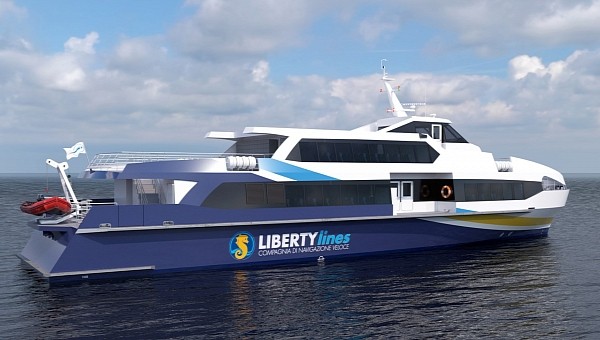Zero-emission ferries could be seen as the equivalent of green public transport buses for regions where maritime transportation predominates. Switching to battery-electric alternatives can be harder for regional mobility, where range and speed are top requirements, but hybrid-propulsion vehicles provide a solution in the meantime.
If cruise lines can only feed their enormous ships with LNG (liquefied natural gas) as a way of cutting emissions, ferry operators have a lot more flexibility. Some of them are in the process of renewing their fleets with brand-new ferries that are adapted for green travel. In the case of Liberty Lines, an Italian operator based in Trapani, we’re talking about hybrid-electric vessels that can lower emission levels without sacrificing performance.
Two big names are backing Liberty Lines’ renewal process. One of them is Incat Crowther, a maritime expert that’s renowned for its yachts as much as for its workboats, and the other is Rolls-Royce, who has committed to adapting its propulsion solutions for the net-zero carbon goal.
Together, these two will give birth to a monohull passenger ferry that’s 38 meters long (125 feet), and fitted with hybrid propulsion. The Rolls-Royce MTU integrated system includes two 16V4000M65L engines and two e-motors, two variable-speed gensets, two gearboxes, and a battery system. Also fitted with a hybrid automation system, the new ferry can switch to various operating modes.
For instance, in full-electric mode, it’s able to travel at eight knots (9.2 mph/14.8 kph) without any emissions. This mode would mainly be used for entering or leaving ports (reducing emissions in ports is one of the main priorities for maritime transportation right now).
When switching to hybrid mode, the ferry is able to reach its top speed of 30 knots (34.5 mph/55.5 kph) and get its batteries charged at the same time (by the main engines). As soon as it’s able to dock somewhere for longer periods of time, it can use the available shore power supply to charge its batteries.
The acclaimed Spanish shipyard Astilleros Armon is in charge of building the future ferries. Each of them will accommodate up to 251 passengers – 166 on the main deck, and 85 on the upper deck. The main deck will also be fitted with a bar and five bathrooms, plus two extra bathrooms on the upper deck. The new ferries are also designed to provide ample storage space, including overhead luggage bins and generous luggage racks.
The Italian ferry operator has already ordered 12 of these new vessels, which are expected to enter service three years from now.
Incat Crowther has also designed a hybrid catamaran with a larger capacity (299 passengers) for the Fullers360 fleet, operating between Auckland and Devonport, in Australia. Plus, it’s known for having designed the longest high-speed ferry in the world, currently being adapted to run on LNG.
Two big names are backing Liberty Lines’ renewal process. One of them is Incat Crowther, a maritime expert that’s renowned for its yachts as much as for its workboats, and the other is Rolls-Royce, who has committed to adapting its propulsion solutions for the net-zero carbon goal.
Together, these two will give birth to a monohull passenger ferry that’s 38 meters long (125 feet), and fitted with hybrid propulsion. The Rolls-Royce MTU integrated system includes two 16V4000M65L engines and two e-motors, two variable-speed gensets, two gearboxes, and a battery system. Also fitted with a hybrid automation system, the new ferry can switch to various operating modes.
For instance, in full-electric mode, it’s able to travel at eight knots (9.2 mph/14.8 kph) without any emissions. This mode would mainly be used for entering or leaving ports (reducing emissions in ports is one of the main priorities for maritime transportation right now).
When switching to hybrid mode, the ferry is able to reach its top speed of 30 knots (34.5 mph/55.5 kph) and get its batteries charged at the same time (by the main engines). As soon as it’s able to dock somewhere for longer periods of time, it can use the available shore power supply to charge its batteries.
The acclaimed Spanish shipyard Astilleros Armon is in charge of building the future ferries. Each of them will accommodate up to 251 passengers – 166 on the main deck, and 85 on the upper deck. The main deck will also be fitted with a bar and five bathrooms, plus two extra bathrooms on the upper deck. The new ferries are also designed to provide ample storage space, including overhead luggage bins and generous luggage racks.
The Italian ferry operator has already ordered 12 of these new vessels, which are expected to enter service three years from now.
Incat Crowther has also designed a hybrid catamaran with a larger capacity (299 passengers) for the Fullers360 fleet, operating between Auckland and Devonport, in Australia. Plus, it’s known for having designed the longest high-speed ferry in the world, currently being adapted to run on LNG.







